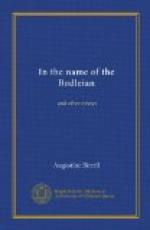How our travellers escaped the ‘national distemper’ and journeyed home by Ecclefechan, Carlisle, Shap Fell, Liverpool, Chester, Coventry, and Warwick must be read in the Journey itself, which, though it only occupies 182 small pages, is full of matter and even merriment; in fact, it is an excellent itinerary.
EPITAPHS
Epitaphs, if in rhyme, are the real literature of the masses. They need no commendation and are beyond all criticism. A Cambridge don, a London bus-driver, will own their charm in equal measure. Strange indeed is the fascination of rhyme. A commonplace hitched into verse instantly takes rank with Holy Scripture. This passion for poetry, as it is sometimes called, is manifested on every side; even tradesmen share it, and as the advertisements in our newspapers show, are willing to pay small sums to poets who commend their wares in verse. The widow bereft of her life’s companion, the mother bending over an empty cradle, find solace in thinking what doleful little scrag of verse shall be graven on the tombstone of the dead. From the earliest times men have sought to squeeze their loves and joys, their sorrows and hatreds, into distichs and quatrains, and to inscribe them somewhere, on walls or windows, on sepulchral urns and gravestones, as memorials of their pleasure or their pain.
’Hark! how chimes the passing bell—
There’s no music to a knell;
All the other sounds we hear
Flatter and but cheat our ear.’
So wrote Shirley the dramatist, and so does he truthfully explain the popularity of the epitaph as distinguished from the epigram. Who ever wearies of Martial’s ’Erotion’?—
’Hic festinata requiescit Erotion umbra,
Crimine quam fati sexta peremit hiems.
Quisquis eris nostri post me regnator agelli
Manibus exiguis annua justa dato.
Sic lare perpetuo, sic turba sospite, solus
Flebilis in terra sit lapis iste tua’—
so prettily Englished by Leigh Hunt:
’Underneath this greedy stone
Lies little sweet Erotion,
Whom the Fates with hearts as cold
Nipped away at six years old.
Those, whoever thou may’st be,
That hast this small field after me,
Let the yearly rites be paid
To her little slender shade;
So shall no disease or jar
Hurt thy house or chill thy Lar,
But this tomb be here alone
The only melancholy stone.’
Our English epitaphs are to be found scattered up and down our country churchyards—’uncouth rhymes,’ as Gray calls them, yet full of the sombre philosophy of life. They are fast becoming illegible, worn out by the rain that raineth every day, and our prim, present-day parsons do not look with favour upon them, besides which—to use a clumsy phrase—besides which most of our churchyards are now closed against burials, and without texts there can be no sermons:




